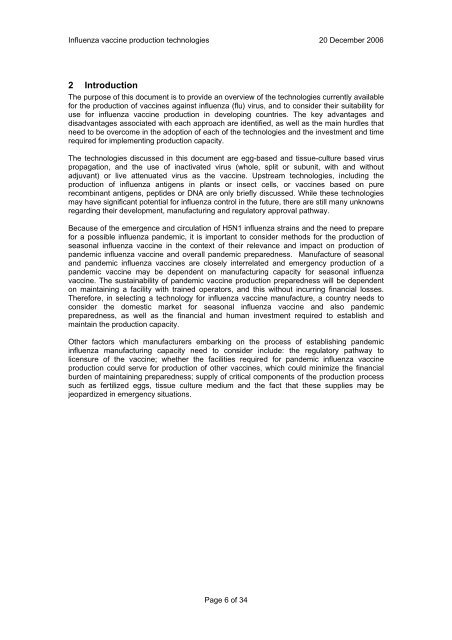A review of production technologies for ... - World Health Organization
A review of production technologies for ... - World Health Organization
A review of production technologies for ... - World Health Organization
You also want an ePaper? Increase the reach of your titles
YUMPU automatically turns print PDFs into web optimized ePapers that Google loves.
Influenza vaccine <strong>production</strong> <strong>technologies</strong> 20 December 2006<br />
2 Introduction<br />
The purpose <strong>of</strong> this document is to provide an overview <strong>of</strong> the <strong>technologies</strong> currently available<br />
<strong>for</strong> the <strong>production</strong> <strong>of</strong> vaccines against influenza (flu) virus, and to consider their suitability <strong>for</strong><br />
use <strong>for</strong> influenza vaccine <strong>production</strong> in developing countries. The key advantages and<br />
disadvantages associated with each approach are identified, as well as the main hurdles that<br />
need to be overcome in the adoption <strong>of</strong> each <strong>of</strong> the <strong>technologies</strong> and the investment and time<br />
required <strong>for</strong> implementing <strong>production</strong> capacity.<br />
The <strong>technologies</strong> discussed in this document are egg-based and tissue-culture based virus<br />
propagation, and the use <strong>of</strong> inactivated virus (whole, split or subunit, with and without<br />
adjuvant) or live attenuated virus as the vaccine. Upstream <strong>technologies</strong>, including the<br />
<strong>production</strong> <strong>of</strong> influenza antigens in plants or insect cells, or vaccines based on pure<br />
recombinant antigens, peptides or DNA are only briefly discussed. While these <strong>technologies</strong><br />
may have significant potential <strong>for</strong> influenza control in the future, there are still many unknowns<br />
regarding their development, manufacturing and regulatory approval pathway.<br />
Because <strong>of</strong> the emergence and circulation <strong>of</strong> H5N1 influenza strains and the need to prepare<br />
<strong>for</strong> a possible influenza pandemic, it is important to consider methods <strong>for</strong> the <strong>production</strong> <strong>of</strong><br />
seasonal influenza vaccine in the context <strong>of</strong> their relevance and impact on <strong>production</strong> <strong>of</strong><br />
pandemic influenza vaccine and overall pandemic preparedness. Manufacture <strong>of</strong> seasonal<br />
and pandemic influenza vaccines are closely interrelated and emergency <strong>production</strong> <strong>of</strong> a<br />
pandemic vaccine may be dependent on manufacturing capacity <strong>for</strong> seasonal influenza<br />
vaccine. The sustainability <strong>of</strong> pandemic vaccine <strong>production</strong> preparedness will be dependent<br />
on maintaining a facility with trained operators, and this without incurring financial losses.<br />
There<strong>for</strong>e, in selecting a technology <strong>for</strong> influenza vaccine manufacture, a country needs to<br />
consider the domestic market <strong>for</strong> seasonal influenza vaccine and also pandemic<br />
preparedness, as well as the financial and human investment required to establish and<br />
maintain the <strong>production</strong> capacity.<br />
Other factors which manufacturers embarking on the process <strong>of</strong> establishing pandemic<br />
influenza manufacturing capacity need to consider include: the regulatory pathway to<br />
licensure <strong>of</strong> the vaccine; whether the facilities required <strong>for</strong> pandemic influenza vaccine<br />
<strong>production</strong> could serve <strong>for</strong> <strong>production</strong> <strong>of</strong> other vaccines, which could minimize the financial<br />
burden <strong>of</strong> maintaining preparedness; supply <strong>of</strong> critical components <strong>of</strong> the <strong>production</strong> process<br />
such as fertilized eggs, tissue culture medium and the fact that these supplies may be<br />
jeopardized in emergency situations.<br />
Page 6 <strong>of</strong> 34

















